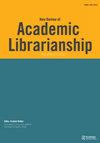Alignment, Collaboration and the Social Turn: Our Agenda for the Relational Library
IF 2.3
Q2 INFORMATION SCIENCE & LIBRARY SCIENCE
引用次数: 1
Abstract
Our profession is “Moving from collecting to connecting” (Kranich, Lotts, Nielsen, & Ward, 2020, p, 285). Academic librarians envision a “social future” (Schlak, Corrall, & Bracke, 2022) as connected connectors, “connecting ideas, knowledge and communities” (University of Leeds Libraries, 2022a), as outward-facing players who “seize opportunities to connect at local, national and international levels” and “purposefully connect and collaborate with strategic partners” (Lancaster University, 2020). Collaboration has emerged as a key theme in academic library discourse and was set to dominate the professional agenda until the COVID-19 pandemic pushed the digital shift into pole position. The pandemic gave commitment to “digital first” a new urgency, but we must not allow our current preoccupation with digital transformation to distract us from the equally important task of developing our capacity to collaborate and embedding a collaborative relational culture in our profession. We have been marching towards the digital library for more than three decades and our journey via online databases, electronic resources, virtual reference, networked services and shared systems has involved a lot of collaboration along the way and not just with other libraries. But our collaborative activities and social relationships have also evolved on a similar timeline, independently and in tandem with that technological trajectory; indeed, collaborations have been instrumental in securing our digital future in scholarly communications with both established and new organisations supporting our work in areas such as content licensing, open access, research data, library publishing and software development. Building tools and building relationships are both important tasks for libraries, but the latter is a prerequisite for the former, which is why we must commit to “collaboration first” (Norman, 1991). We cannot discover, define, design, develop and deliver interventions to enhance research and learning without “a deep, fundamental understanding of people and groups”; in particular, an understanding of their individual and group activities, which are “vastly different” and hence require an understanding of “the complex social and cultural aspects of their interaction” (Norman, 1991, p. 89). Norman’s (1991) call for systems designers to engage in “collaborative computing” is reflected in the collaborative and participatory service design processes that are now widely used in academic libraries, often led by user experience (UX) librarians (Bell, 2014; Marquez & Downey, 2015; Somerville & Collins, 2008). Steven Bell (2014, pp. 379, 380) goes on to suggest that “academic librarians must continue to seek out opportunities to leverage both the technology and the power of relationships to design a library experience that supports student and faculty success” and asserts that “The differentiating capacity of the future academic library ... is personal relationships with academic librarians”. The UX movement is one example of the “pervasive collaborative turn that has impacted many sectors of society, including higher education” (Saltmarsh, 2017, p. 3) and maybe not the first that comes to mind when we talk about collaboration and the academic library. But integrating co-design and other on-the-ground collaborative activity into everyday practice is just as urgent as lofty https://doi.org/10.1080/13614533.2023.2196277对齐、协作和社会转向:我们的关系图书馆议程
我们的职业是“从收集走向连接”(Kranich, Lotts, Nielsen, & Ward, 2020, p . 285)。学术图书馆员将“社会未来”(Schlak, Corrall, & Bracke, 2022)设想为连接的连接器,“连接思想,知识和社区”(利兹大学图书馆,2022a),作为面向外部的参与者,“抓住机会在地方,国家和国际层面进行连接”,“有目的地与战略合作伙伴建立联系和合作”(兰开斯特大学,2020)。协作已成为学术图书馆话语中的一个关键主题,并将主导专业议程,直到2019冠状病毒病大流行将数字化转变推向极点。大流行病使“数字优先”的承诺具有新的紧迫性,但我们绝不能让目前对数字转型的关注分散我们对同样重要的任务的注意力,即发展我们的协作能力和在我们的专业中嵌入协作关系文化。三十多年来,我们一直在向数字图书馆迈进,通过在线数据库、电子资源、虚拟参考、网络服务和共享系统,我们的旅程涉及到许多合作,而不仅仅是与其他图书馆。但我们的合作活动和社会关系也在类似的时间轴上发展,独立地与技术轨迹同步;事实上,在内容许可、开放获取、研究数据、图书馆出版和软件开发等领域,与现有和新成立的组织合作,有助于确保我们在学术交流方面的数字化未来。构建工具和构建关系都是图书馆的重要任务,但后者是前者的先决条件,这就是为什么我们必须承诺“协作第一”(Norman, 1991)。如果没有“对人和群体的深刻、基本的了解”,我们就无法发现、定义、设计、开发和提供干预措施来加强研究和学习;特别是,理解他们的个人和群体活动,这是“非常不同的”,因此需要理解“他们相互作用的复杂的社会和文化方面”(诺曼,1991,第89页)。Norman(1991)呼吁系统设计师参与“协同计算”,这反映在协作和参与式服务设计过程中,这种设计过程现在被广泛应用于学术图书馆,通常由用户体验(UX)图书管理员领导(Bell, 2014;Marquez & Downey, 2015;Somerville & Collins, 2008)。Steven Bell (2014, pp. 379,380)继续建议“学术图书馆馆员必须继续寻找机会,利用技术和关系的力量来设计支持学生和教师成功的图书馆体验”,并断言“未来学术图书馆的差异化能力……是与学术图书馆员的私人关系”。用户体验运动是“普遍的协作转向影响了社会的许多部门,包括高等教育”的一个例子(Saltmarsh, 2017, p. 3),当我们谈论协作和学术图书馆时,可能不是第一个想到的例子。但是,将共同设计和其他实地协作活动整合到日常实践中,就像崇高的https://doi.org/10.1080/13614533.2023.2196277一样紧迫
本文章由计算机程序翻译,如有差异,请以英文原文为准。
求助全文
约1分钟内获得全文
求助全文
来源期刊

New Review of Academic Librarianship
Social Sciences-Library and Information Sciences
CiteScore
3.40
自引率
0.00%
发文量
20
 求助内容:
求助内容: 应助结果提醒方式:
应助结果提醒方式:


